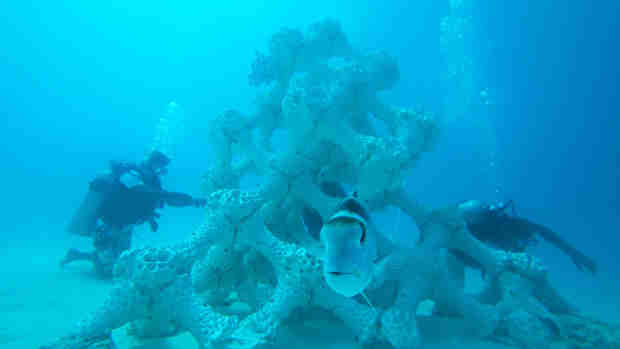World’s “Largest” 3-D Printed Reef Installed in Maldives
A 3-D printed reef – claimed to be the world’s largest – was submerged on Saturday at Summer Island Maldives. It is stated to be a new technology-driven method to help coral reefs survive a warming climate.
The artificial reef, assembled with hundreds of ceramic and concrete modules, was submerged at Summer Island’s ‘Blue Lagoon’ — a sandy part of the lagoon, where the resort hopes to create a new coral reef ecosystem.
The project started in a lab in Melbourne, Australia, where industrial designer Alex Goad of Reef Design Lab used sophisticated computing modeling to design reef structures similar to the coral reefs found naturally in the Maldives.
A large 3-D printer whirred away for 24 hours to print moulds of the reef structures. These moulds were cast in ceramic — an inert substance, similar to the calcium carbonate found in coral reefs. The ceramic moulds were shipped to the Maldives, and filled with concrete on the beach at Summer Island.
Then 220 ceramic, concrete filled moulds were slotted together, like a giant LEGO set, to create the new reef. It sits in seven metres of water, close to the resort’s existing coral nursery.
Fragments of coral from the nursery are being transplanted onto the 3-D reef, where they will grow and colonise the structure. In a year or two, when the corals have grown over the 3-D reef, the resort hopes to have a new, natural looking reef, teeming with fish and marine life.
If the 3-D printing technology proves more successful at growing corals than existing coral propagation methods, it could be a novel way of helping coral reefs survive a warming climate.
The Maldives is one of the world’s most climate-vulnerable nations. Rising sea temperatures pose a grave threat to the world’s coral reefs, and mass bleaching events are becoming more common and more severe.
Summer Island Maldives has implemented a number of recent environmental initiatives, including the adoption of solar energy, a ban on the use of plastic straws, phasing out imported drinking water, and coral conservation projects.














